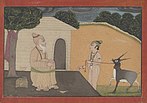
Back Upanishad Afrikaans उपनिषद ANP الأبانيشاد Arabic উপনিষদ Assamese Upanishads AST Upanişadlar Azerbaijani Upanishad BCL Упанішады Byelorussian Упанишади Bulgarian उपनिषद Bihari
| Upanishads | |
|---|---|
Clockwise from top left:
| |
| Information | |
| Religion | Hinduism |
| Language | Sanskrit |
| Part of a series on |
| Hindu scriptures and texts |
|---|
 |
| Related Hindu texts |
The Upanishads (/ʊˈpʌnɪʃədz/;[1] Sanskrit: उपनिषद्, IAST: Upaniṣad, pronounced [ˈʊpɐnɪʂɐd]) are late Vedic and post-Vedic Sanskrit texts that "document the transition from the archaic ritualism of the Veda into new religious ideas and institutions"[2] and the emergence of the central religious concepts of Hinduism.[2][note 1] They are the most recent addition to the Vedas, the oldest scriptures of Hinduism, and deal with meditation, philosophy, consciousness, and ontological knowledge. Earlier parts of the Vedas dealt with mantras, benedictions, rituals, ceremonies, and sacrifices.[3][4][5]
While among the most important literature in the history of Indian religions and culture, the Upanishads document a wide variety of "rites, incantations, and esoteric knowledge"[6] departing from Vedic ritualism and interpreted in various ways in the later commentarial traditions. The Upanishads are widely known, and their diverse ideas, interpreted in various ways, informed later traditions of Hinduism.[note 1] The central concern of all Upanishads is to discover the relations between ritual, cosmic realities (including gods), and the human body/person,[7] postulating Ātman and Brahman as the "summit of the hierarchically arranged and interconnected universe,"[8][9][10] but various ideas about the relation between Atman and Brahman can be found.[10][note 2]
Around 108 Upanishads are known, of which the first dozen or so are the oldest and most important and are referred to as the principal or main (mukhya) Upanishads.[11][12] The mukhya Upanishads are found mostly in the concluding part of the Brahmanas and Aranyakas[13] and were, for centuries, memorized by each generation and passed down orally. The mukhya Upanishads predate the Common Era, but there is no scholarly consensus on their date, or even on which ones are pre- or post-Buddhist. The Brhadaranyaka is seen as particularly ancient by modern scholars.[14][15][16] Of the remainder, 95 Upanishads are part of the Muktikā canon, composed from about the last centuries of 1st-millennium BCE through about 15th-century CE.[17][18] New Upanishads, beyond the 108 in the Muktika canon, continued to be composed through the early modern and modern era,[19] though often dealing with subjects that are unconnected to the Vedas.[20] The mukhya Upanishads, along with the Bhagavad Gita and the Brahmasutra (known collectively as the Prasthanatrayi),[21] are interpreted in divergent ways in the several later schools of Vedanta.[10][note 3][22]
With the translation of the Upanishads in the early 19th century they started to attract attention from a Western audience. German philosopher Arthur Schopenhauer was deeply impressed by the Upanishads and called them "the most profitable and elevating reading which ... is possible in the world."[23] Modern era Indologists have discussed the similarities between the fundamental concepts in the Upanishads and the works of major Western philosophers.[24][25][26]
- ^ "Upanishad" Archived 20 September 2014 at the Wayback Machine. Random House Webster's Unabridged Dictionary.
- ^ a b Olivelle 1996, p. xxiii.
- ^ Flood (1996), p. 35–39.
- ^ A Bhattacharya (2006), Hindu Dharma: Introduction to Scriptures and Theology, ISBN 978-0595384556, pp. 8–14; George M. Williams (2003), Handbook of Hindu Mythology, Oxford University Press, ISBN 978-0195332612, p. 285
- ^ Jan Gonda (1975), Vedic Literature: (Saṃhitās and Brāhmaṇas), Otto Harrassowitz Verlag, ISBN 978-3447016032
- ^ Patrick Olivelle 1998, pp. 51.
- ^ Olivelle 1996, p. lii.
- ^ Olivelle 1996, p. lv.
- ^ Mahadevan 1956, p. 59.
- ^ a b c Raju (1985), p. 35-36.
- ^ Cite error: The named reference
stephenphillipswas invoked but never defined (see the help page). - ^ E Easwaran (2007), The Upanishads, ISBN 978-1586380212, pages 298-299
- ^ Mahadevan 1956, p. 56.
- ^ Cite error: The named reference
olivelleintrowas invoked but never defined (see the help page). - ^ King 1995, p. 52.
- ^ Bronkhorst, Johannes (2007). Greater Magadha: Studies in the Culture of Early India, pp. 258-259. BRILL.
- ^ Olivelle 1992, pp. 5, 8–9.
- ^ Flood 1996, p. 96.
- ^ Ranade 1926, p. 12.
- ^ Varghese 2008, p. 101.
- ^ Ranade 1926, p. 205.
- ^ Max Müller, The Upanishads, Part 1, Oxford University Press, page LXXXVI footnote 1
- ^ Clarke, John James (1997). Oriental Enlightenment: The Encounter Between Asian and Western Thought. Abingdon, Oxfordshire: Routledge. p. 68. ISBN 978-0-415-13376-0. Archived from the original on 17 May 2021. Retrieved 31 March 2020.
- ^ Deussen 2010, p. 42, Quote: "Here we have to do with the Upanishads, and the world-wide historical significance of these documents cannot, in our judgement, be more clearly indicated than by showing how the deep fundamental conception of Plato and Kant was precisely that which already formed the basis of Upanishad teaching"..
- ^ Lawrence Hatab (1982). R. Baine Harris (ed.). Neoplatonism and Indian Thought. State University of New York Press. pp. 31–38. ISBN 978-0-87395-546-1. Archived from the original on 17 May 2021. Retrieved 4 November 2016.;
Paulos Gregorios (2002). Neoplatonism and Indian Philosophy. State University of New York Press. pp. 71–79, 190–192, 210–214. ISBN 978-0-7914-5274-5. - ^ Ben-Ami Scharfstein (1998). A Comparative History of World Philosophy: From the Upanishads to Kant. State University of New York Press. pp. 62–74. ISBN 978-0-7914-3683-7. Archived from the original on 18 December 2021. Retrieved 4 November 2016.
Cite error: There are <ref group=note> tags on this page, but the references will not show without a {{reflist|group=note}} template (see the help page).
© MMXXIII Rich X Search. We shall prevail. All rights reserved. Rich X Search



